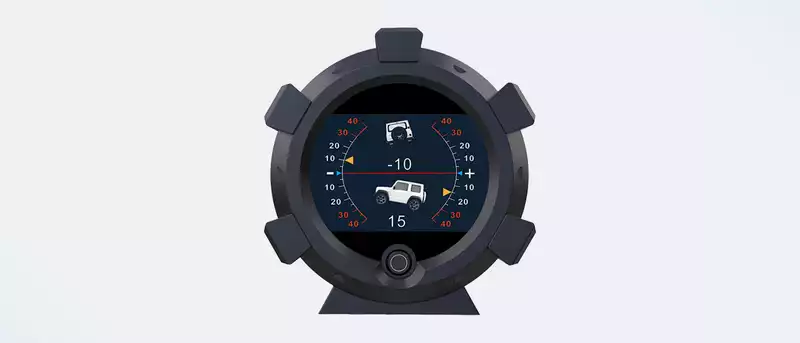Autool's X95 GPS Slope Meter combines data from a GPS module and built-in sensors to display speed along with the vehicle's inclination and left and right roll angles; at $65, it can warn of a likely rollover, making it a necessity for those in the habit of driving off-road.
Priced at $65, the Autool X95 GPS Slope Meter can indicate to drivers their current speed and whether their vehicle is about to tip over. The company sells a variety of professional and amateur automotive equipment and tools.
The Autool X95 GPS Slope Meter is designed for those who spend more of their driving time on dirt trails and mountain ridges than on paved highways. in addition to being able to display GPS-based speed, various built-in sensors measure the vehicle's slope and roll angle The 3.3 x 3.2 x 2.2-inch X95 is housed in a hemispherical plastic case and weighs just 2.9 ounces.
The unit's 2.1-inch direct-view color screen can display the angle of the vehicle in two ways for instant recognition. It is displayed as numerical data for lateral sway (top) and front/rear tilt (bottom). The system can also warn of speeding violations, but its real value lies in the fact that the tilt interface alerts when the vehicle reaches 30 degrees.
The interface has a single button that can be easily shuffled through the major screen layouts with a short press. Selections can range from speed, time, date, number of satellites in contact, and a numerical overview of the main unit's data. A long press on the button opens the settings section, where units, alarm settings, and screen colors can be changed.
In addition to the adhesive pad, the package includes a 12-volt accessory outlet adapter, a 55-inch cable, and a short cable stripped at both ends to wire directly to the vehicle's fuse box. A big bonus is that the adapter comes with two USB-A outlets that can output 2.4 amps.
Based on GPS satellite data, the device is limited to speed, time, and distance parameters; since there is no OBD connection, there is no option to display the Akaba A500's engine RPM or coolant temperature level. There is also no phone integration, so the X95 does not have Hudway Drive's phone-based turn-by-turn guidance feature.
The Autool X95 fits nicely in the dashboard, but lacks the adjustable base that other Autool devices have. The X95 GPS slope meter should work on any vehicle on the road today because it does not rely on OBD data -- although it lacks an on/off switch.
The thick power cable is a bit harder to hide in the dashboard than the flat wire. The system's tall design also slightly obstructs forward vision, but there are worse HUDs on the market.
The X95 GPS slope meter unit comes with a three-year warranty and an eight-page start-up booklet. Sadly, there is no online documentation.
After I plugged the X95 GPS Slope Meter into the cigarette lighter outlet of my 2014 Audi A4 AllRoad, it took over three minutes for the device's GPS module to contact the nearest satellite. When the car was shut down, it immediately turned off.
On long drives, the device responded well to changes on the road and accurately recorded the car's tilt and roll angles. When the car reached 30 degrees, the built-in rollover alarm was triggered. Unfortunately, the X95 GPS slope meter does not utilize the car's on-board diagnostics, so it lacks what other HUDs offer, such as a tachometer or temperature gauge.
The unit has an ambient light sensor that adjusts the brightness of the display to match day and night. On the downside, the screen tended to turn white in direct sunlight, making it difficult to read.
The Autool X95 GPS Slope Meter is a great way to see if your car is getting too close to the edge on the slope and roll angle gauge. However, the unit relies primarily on GPS data, and only on GPS data, meaning there is no feedback regarding the car's internal operation.
The Autool X95 is small, lightweight, and not very expensive at $65. However, it is primarily intended for people who go off-road a lot. In other words, people who are used to driving on paved roads or highways may be better off buying a different device.
.









Comments